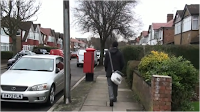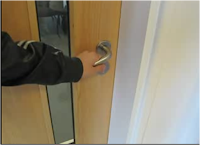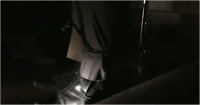Dear Moderator,
Thank you for looking at my blog, and hope you enjoyed it!
Devki (:
Devki's Thriller Blogg
Candidate Name: Devki Mistry Candidate Number: 6144
Monday, 14 March 2011
Sunday, 13 March 2011
Evaluation 7: Looking back at your preliminary task (the continuity editing task), what do you feel you have learnt in the progression from it to full product?
The aim of our project was to create a thriller opening of a fiction film. To give us a taste of the different camera shots and editing techniques needed, we were given a preliminary exercise, which involved 'filming and editing a character opening a door, and crossing a room and sitting down in a chair opposite another character, with whom he/she would exchange a couple of line of dialogue.' We had to demonstrate match on action, shot/reverse shot and the 180-degree angle. For this task, we did not carry out vast amounts of research, except the types of camera shots we were going to film. We did this by story-boarding all the shots. Whereas for our thriller opening sequence, we researched into real media products, and looked at what was successful about them. As our film opening had to be of a thriller genre, we had to research into thriller conventions, for example use of low lighting, not being able to see the characters identity to create an enigma etc. We also planned thoroughly each shot and frame we were going to create, and how we were going to edit the sequence for example the software's we were going to use. This enabled the process of making the film opening to go smoothly as we knew what we were doing, and what needed to be done, and so accordingly planned out our time.
During the process, I have learnt a variety of different camera angles and shots used in film production. When we produced the preliminary task, I had very basic knowledge of shots and angles. Examples of shots we used in our preliminary task are long shots, close-ups and over-the-shoulder shots. The long shots, enabled us to introduce the character's full identity. The close-up helps to keep the audience's attention on the scene, emphasizing what is in the shot. Our knowledge of camera angles and shots developed when we began to research into different media products, and were introduced to them. Examples of new shots we learnt point-of-view, tracking, panning, mid-shots, high angle etc. I also learnt continuity techniques. The preliminary exercise taught me that to make a film successful, the shots have to flow. Our film was successful at creating continuity as we planned how we were going to crop each frame.


The screengrabs above are examples of a 'long-shot'. On the left is the shot from our thriller opening sequence and on the right is the shot from our preliminary task. This shot usually introduces the beginning of every scene. It sets in motion the audience's perception of time, place and action of the scene that is about to happen.


These are examples of close-up shots. They are used for showing detail and emphasizing what is in the frame. On the left is the shot from our thriller opening sequence and on the right is the shot from our preliminary task. To carry out this shot, the camera has to be fairly close to what is being concentrated on.
During the process, I have learnt a variety of different camera angles and shots used in film production. When we produced the preliminary task, I had very basic knowledge of shots and angles. Examples of shots we used in our preliminary task are long shots, close-ups and over-the-shoulder shots. The long shots, enabled us to introduce the character's full identity. The close-up helps to keep the audience's attention on the scene, emphasizing what is in the shot. Our knowledge of camera angles and shots developed when we began to research into different media products, and were introduced to them. Examples of new shots we learnt point-of-view, tracking, panning, mid-shots, high angle etc. I also learnt continuity techniques. The preliminary exercise taught me that to make a film successful, the shots have to flow. Our film was successful at creating continuity as we planned how we were going to crop each frame.


The screengrabs above are examples of a 'long-shot'. On the left is the shot from our thriller opening sequence and on the right is the shot from our preliminary task. This shot usually introduces the beginning of every scene. It sets in motion the audience's perception of time, place and action of the scene that is about to happen.


These are examples of close-up shots. They are used for showing detail and emphasizing what is in the frame. On the left is the shot from our thriller opening sequence and on the right is the shot from our preliminary task. To carry out this shot, the camera has to be fairly close to what is being concentrated on.
This is a point of view shot. It enables the audience to see the scene from the character's perspective.
This is an establishing shot. It used to introduce or set the scene. It is designed to show to show the audience where the action is taking place.It is usually a wide shot or extreme wide shot.
This is high angle shot. The camera is elevated above the action. They make the object photographed seem smaller, and less significant. It may portray status, so in this case the character is seen to be vulnerable and helpless.
When we were editing our preliminary task, we were introduced to a software on the mac, called 'Final Cut Express'. The software enabled us to cut/crop frames, create titles and add special effects to the frames. At first it took it bit of getting used to, but as we progressed we became familiar and confident with all the different tools involved. While creating our film opening sequence we also learnt how to use other software's such as Adobe After Effects and Garageband. After producing the preliminary task, I felt we learnt that planning and research is a big part of creating a product. This helps us to know exactly what we are doing, while shooting, and what we need to achieve to create a successful film opening. My knowledge of camera shots/angles and editing techniques has developed a lot since we created the preliminary task.
Overall, I feel that our thriller film opening was quite successful as we had researched thoroughly into thriller conventions and were able to create these. We found the most successful part of our opening were the 'torture scenes'. It had good use of lighting linking with the conventions of the thriller genre.
Subscribe to:
Posts (Atom)


